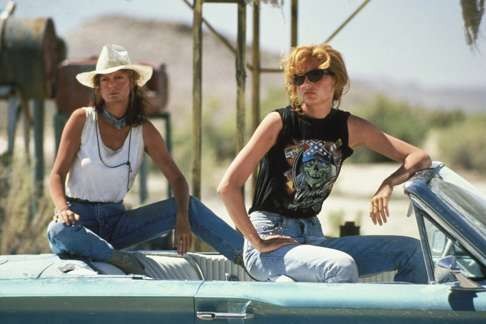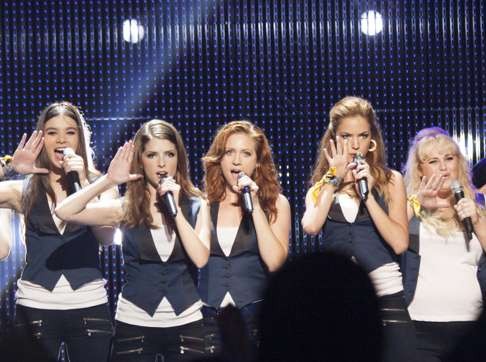
25 years after Thelma & Louise, Hollywood still won’t put women in driver’s seat
Women are under-represented in Hollywood, there are fewer female characters than there are males in films, they get less dialogue and are three times as likely as men to appear in the nude
It’s been 25 years since Geena Davis and Susan Sarandon hit the desert highway in Thelma & Louise, Ridley Scott’s rollicking road flick that dared to put women in the driver’s seat – and kept them there to the iconic end, soaring into the open maw of the Grand Canyon in a turquoise Thunderbird convertible.
Finally! said feminists, excited to see complex, stereotype-busting female characters.
Revolutionary! said reviewers, acknowledging the unprecedented.
Misandry! said a few (mostly male) detractors, who thought the film vilified men and glorified violence.
Thelma & Louise told the story of a bored waitress and a disillusioned housewife whose road trip spirals into a crime spree after one kills a man who was attempting to rape the other. But it was also funny and action-filled and thoughtful - and a box-office success after it opened in May 1991, grossing US$45 million in the US. And it seemed to mark a cinematic and cultural milestone that could change the role of women on-screen.

“Ten years from now it will be seen as a turning point,” said the Boston Phoenix’s Peter Keough.
Geena Davis was definitely eager to believe it. She had already logged a decade in Hollywood and won a best-supporting actress Oscar, but Thelma & Louise was her first marquee role in such a high-profile film. “We were so unprepared for the reaction that it got, and it was sort of overwhelming and exciting,” she said, speaking by phone from her home in Los Angeles. “I thought, ‘Oh, yeah, things are going good for women.’ I just assumed things were getting better all the time.”
So much for that. Two new studies of current cinema recently underscored the lingering sense that women have lost their grip on the big screen.
One found that women have a disproportionate share of the nude scenes – three times as many as men.
The other found that men have a disproportionate share of the dialogue.
Even more startling, the latter study, from the website Polygraph, found in its analysis of more than 2,000 films that male characters speak more than women even in women-centric movies. Disney’s smash hit Frozen might celebrate sisterhood, but 57 per cent of the dialogue comes from male characters. Even Katniss Everdeen, the fierce hero in The Hunger Games, and her female co-stars don’t speak as many words as the male supporting characters combined in the trilogy’s film adaptations.
The nudity data points came in a larger study from LA’s Mount Saint Mary’s University, which also found that of the top-grossing 100 films of 2014, only 12 per cent featured a female lead character.
The new reports dovetail with research conducted by Davis’s own advocacy organisation. The Geena Davis Institute on Gender in Media found that the percentage of female speaking characters in the top-grossing films hasn’t changed in roughly half a century.
“We have so few parts, and they’re not often really good parts,” Davis says. “It’s like this Woody Allen joke about a restaurant - not only is the food so bad, but the portions are so small.”
Davis, a vocal women’s rights activist who launched the pro-diversity Bentonville Film Festival last year, says the absence of women in film has become so standard that most of us don’t even notice it. Sure, there are exceptions, but they are so few that quibblers end up citing the same ones over and over. (Hey, what about A League of Their Own? What about Bridesmaids?)
Davis says the statistics prove that a few blockbuster hits for women aren’t enough to level the playing field. Her solution?
“The No. 1 thing I think should be happening is that I get to see every script before they make it,” Davis deadpans. Then she laughs. “I could very easily make a few strokes with a pen and fix it.”
Seriously, though: “Before you cast [a film], go through and change a bunch of first names to female,” she says. And make sure that any crowd scenes include an equal number of women. And remember that female characters also deserve powerful jobs.
“What our research has shown, which is very disturbing as far as occupation of female characters goes, is that while the percentage of female CEOs and presidents and justices and things like that are low in the real world, there are far fewer on screen in fiction. And it’s fiction,” she says, raising her voice. “The fact that we’re not even able to reflect the abysmal reality is really kind of horrifying.”

“Films that have more women and more diversity make more money,” Davis says. Putting women and people of colour on-screen is not about being charitable or politically correct, “it’s about reflecting the audience and showing the world as it actually is, which is 51 per cent female and very diverse.”
That’s exactly what Davis plans to do next month when she hosts her second annual film festival in Bentonville, Arkansas. The fledgling festival focuses on films that feature women and diverse casts; it’s unusual in that it guarantees theatrical or TV distribution to its winners, “which is huge”, Davis says. “I’ve had so many filmmakers tell me that getting distribution is harder than making the movie.”
Even if Thelma & Louise didn’t transform the role of women in Hollywood, it left a mark on the women involved with it. Callie Khouri won an Oscar for her screenplay; while she got a couple other female-dominated stories onto the big screen – notably, Divine Secrets of the Ya-Ya Sisterhood – she’s made a bigger splash lately on TV, as creator and producer of ABC’s country-diva saga, Nashville.
The film was only the second in history to score two best-actress Oscar nominations, boosting the careers of both Sarandon and Davis. Sarandon won the Oscar for 1995’s Dead Man Walking and has been among the few older actresses to maintain a thriving career. Davis, meanwhile, had another female-driven pop-culture phenomenon in 1992 with A League of Their Own, co-starring a slew of young actresses as a 1940s women’s baseball team. But after one notorious box-office bomb – Cutthroat Island, her effort to claim a piece of the lucrative, male-dominated action-adventure genre – Davis started working more in TV. She won a Golden Globe in 2006 for playing the first female president in Commander in Chief.

The film forever changed Davis’ perception of gender equality on-screen, she says: “It was really a big wake-up call about how rarely we give women an opportunity to feel excited and inspired by the female characters.”
And we were excited by those characters. Beyond the movie’s progressive politics, Thelma and Louise were gritty and funny and sexy, and their wild ride was damn entertaining.
The industry is finally catching on, Davis says. Just not fast enough.
“In all the spheres of society where there is tremendous gender inequality, the one area where change can happen overnight is on-screen,” she says. “It’s going to take forever to get Congress to be half women, but there could be a half-women Congress tomorrow in the next movie somebody makes.”
She laughs. “I’m an impatient optimist.”
(In Thelma’s words: let’s keep going.)
The Washington Post

